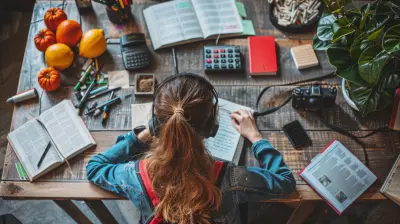Art as a Form of Communication for Non-Verbal Students
19 August 2025
The Silent Symphony of Expression
Imagine carrying a world of thoughts, emotions, and stories inside you, yet being unable to speak them into existence. Frustrating, isn’t it? Now, picture a paintbrush, a lump of clay, or even just a handful of colorful crayons bridging that gap between silence and expression.
For non-verbal students, art isn’t just an extracurricular activity—it’s a language, a voice, a way to tell their stories without uttering a single word. It’s the poetry of the hands, the symphony of colors, the unspoken dialogue between heart and canvas.

Breaking Barriers with Brushstrokes
Words can be limiting. Even for those who speak fluently, some emotions are too complex to be put into sentences. But what about those who can’t use spoken language at all?Non-verbal students face daily challenges in expressing needs, feelings, or even simple thoughts. Traditional communication tools like sign language or assistive technology help, but they can still feel restrictive. This is where art becomes a universal translator.
Why Art?
Art gives freedom. Unlike spoken or written language, it has no rigid rules. One painting can hold a thousand emotions. A sculpture can embody a lifetime of experiences. Non-verbal students can use colors, textures, and shapes to communicate their thoughts without struggling to find the right words.It’s not just about painting on a canvas either. Art can be:
- Drawing and sketching – expressing ideas through lines and shades
- Sculpting and molding – giving shape to emotions
- Digital art – using technology to create limitless possibilities
- Collage and mixed media – piecing together thoughts from different sources
- Dance and movement – transforming energy into expression
Each of these mediums offers a unique way for non-verbal students to share their world with others.

Art as an Emotional Outlet
Ever felt a lump in your throat when emotions became too overwhelming? Now, imagine being unable to verbalize them at all.Art becomes a release valve, a safe space where non-verbal students can pour out their emotions without fear of being misunderstood. A simple color choice—deep blues or fiery reds—can tell more than a thousand words ever could.
Healing Through Creative Expression
Psychologists often use art therapy to help individuals process emotions, and it works wonders for non-verbal students. Creating something tangible from feelings not only helps in expressing emotions but also in understanding them.- A child struggling with anxiety may find comfort in soft, flowing watercolors.
- A student feeling trapped may create sharp, jagged drawings or heavy, layered paintings.
- Happiness can explode onto the page in bright splashes of yellow and orange.
Every stroke, every texture, every chosen material speaks of something deeper. And the beautiful part? There’s no wrong way to do it.

Artistic Communication in Education
Schools often emphasize verbal skills—reading, writing, speaking. But what if we broadened the definition of communication?For non-verbal students, a drawing can be their essay, a sculpture their story, a movement their response. Recognizing these forms of expression as valid and valuable opens up a world of possibilities in education.
Incorporating Art in Learning
Teachers can integrate art into daily lessons to help non-verbal students engage actively.- Visual storytelling – Instead of writing, students illustrate their thoughts
- Project-based learning – Using sculpture, craft, or digital art to showcase understanding
- Interactive art sessions – Encouraging teamwork and collaboration without words
- Color-coded emotional charts – Letting students express feelings using different hues
By allowing artistic expression in classrooms, educators give non-verbal students the stage to speak in their own way.

The Role of Technology in Artistic Expression
In today’s digital age, technology bridges many communication gaps. And for non-verbal students? It opens an entirely new world of artistic possibilities.- Tablet drawing apps let students create intricate designs with just a swipe.
- Virtual reality art tools allow immersive artistic exploration.
- Speech-to-art software interprets emotions and transforms them into visuals.
With these advancements, art becomes not just an outlet but an interactive language, evolving to meet each student's unique needs.
Building Confidence Through Art
There’s something magical about watching a student's eyes light up when they see their artwork admired. It’s the silent but powerful affirmation that their voice matters—even if it’s expressed differently.Art fosters:
- Self-esteem – Pride in creating something meaningful
- Connection – Making bonds through shared artistic experiences
- Independence – Expressing thoughts without assistance
For non-verbal students, every brushstroke is a declaration: “I am here. I have something to say.”
Encouraging Artistic Communication at Home
Parents and guardians can nurture this form of expression outside of school, too. Here’s how:- Provide diverse materials – Offer paints, clay, recycled items—let creativity flow freely.
- Encourage without limits – Don’t dictate what art should look like; let them lead.
- Create a judgment-free zone – Appreciate effort, not just results.
- Celebrate their work – Display their art proudly, showing their expression matters.
Art isn’t about perfection—it’s about saying what’s inside without words.
The Universal Language of Art
No matter where you are in the world, a smile means happiness, tears symbolize sadness, and art? Art is a language everyone can understand—especially those who struggle with traditional communication.For non-verbal students, art isn’t just an activity. It’s a lifeline, a portal to self-expression, a way to be heard. Let’s embrace it, encourage it, and most importantly, see it for what it truly is: the power of silent voices speaking through vibrant creativity.
all images in this post were generated using AI tools
Category:
Art EducationAuthor:

Olivia Lewis
Discussion
rate this article
1 comments
Anastasia Perry
Art transcends barriers, allowing non-verbal students to express their emotions and ideas. It empowers voices often unheard, fostering connection and understanding. Let creativity illuminate the path to communication!
September 6, 2025 at 3:10 AM

Olivia Lewis
Thank you for highlighting the transformative power of art! It truly is a vital means for non-verbal students to connect and express themselves.


